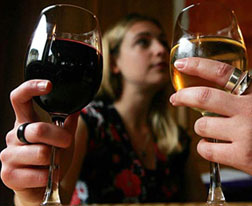Fact Sheet: Women and Alcohol
 |
Advertising
- Girls, ages 12 to 20, saw 68% more beer advertising than women of legal age on a per capita basis in magazines in 2002, while boys, ages 12 to 20, saw 29% more beer advertising than men on a per capita basis. 1
- Some alcohol industry executives also see older women and a prime target, and describe them as a "grey opportunity." 2
Consumption
- More than 4.4 million women in the U.S. are alcoholics or abuse alcohol. 3
- Girls are increasing their rate of binge drinking. Boys are bingeing less or increasing their bingeing at a slower rate than girls their age.
- Twelfth-grade female drinkers and binge drinkers are more likely to drink distilled spirits than beer. 5
- Two nationwide polls found that approximately one-third of teenage girls had tried alcopops (or “Flavored Malt Beverages”), and one out of six had done so in the past six months. Further, more teen girls had drunk alcopops in the past six months than teen boys (31% versus 19%). 6
Health
- Women metabolize alcohol much faster than men. When women and men of the same body weight drink the same amount of alcohol, women reach higher peak blood alcohol levels. 7
- Females who drink regularly generally experience an accelerated development of alcohol-related problems compared to males, known as the “telescoping effect.” 8
- One in four ninth grade sexually active girls and 20% of all sexually active high school girls reported using alcohol or drugs at the time of their last sexual encounter. 9
- Teenage girls who binge drink are up to 63% more likely to become teen mothers than those who do not drink. 10
- Heavy alcohol use compromises bone health and increases the risk of osteoporosis by decreasing bone density and weakening the bones. These effects are especially striking in young women, whose bones are still developing. 11
- A study cited by the American Cancer Society finds that consumption of one alcoholic beverage per day increases the lifetime risk of a woman developing breast cancer by 10%. This increases the chance of breast cancer diagnoses from one in eight to one in seven for the average woman consuming one alcoholic drink per day. 12
- Alcohol also is linked to cancers of the digestive tract and of the head and neck (the risk is especially high in smokers who also drink heavily). 13
- Women are more likely than men to develop alcoholic hepatitis (liver inflammation) and to die from cirrhosis. 14
- Most alcoholics have some loss of mental function, reduced brain size, and changes in the function of brain cells. Research suggests that women are more vulnerable than men to alcohol-induced brain damage. 15
- Chronic heavy drinking is a leading cause of cardiovascular disease. Among heavy drinkers, men and women have similar rates of alcohol-related heart disease, even though women drink less alcohol over a lifetime than men. 16
For more information on this topic see:
- Women Under the Influence written by The National Center on Addiction and Substance Abuse (CASA) at Columbia University and published by The Johns Hopkins University Press in February 2006
- The Formative Years: Pathways to Substance Abuse Among Girls and Young Women Ages 8-22. The National Center on Addiction and Substance Abuse (CASA) at Columbia University 2003
1. David H. Jernigan, Joshua Ostroff, Craig Ross, and James A. O'Hara III, "Sex Differences in Adolescent Exposure to Alcohol Advertising in Magazines," Arch Pediatr Adolesc Med 158 (July 2004): 629-634.
2. Realbeer.com, “Interbrew wants more women drinkers.” , April 2003
3. The Formative Years: Pathways to Substance Abuse Among Girls and Young Women Ages 8-22 The National Center on Addiction and Substance Abuse (CASA) at Columbia University 2003.
4. G. Newes-Adeyi, C.M. Chen, G.D. Williams, V.B. Faden, Surveillance Report #74: Trends in Underage Drinking in the United States, 1991-2003 (Washington, DC: National Institute on Alcohol Abuse and Alcoholism,October 2005), 1. Available at http://pubs.niaaa.nih.gov/publications/surveillance74/Underage%2074.pdf (accessed March 14, 2006).
5. Monitoring the Future, unpublished data provided to David H. Jernigan, PhD in e-mails from Lloyd Johnston January 25, 2006 and Ginger Maggio, February 23, 2006.
6. American Medical Association,“Teenage Girls Targeted for Sweet flavored Alcoholic Beverages,” press release, December 16, 2004.
7. U.S. Department of Health and Human Services, Public Health Service. 10th Special Report to the U.S. Congress on Alcohol and Health, 254.
8. The Formative Years: Pathways to Substance Abuse Among Girls and Young Women Ages 8-22 The National Center on Addiction and Substance Abuse (CASA) at Columbia University 2003 .
9. Ibid.
10. T. S.Dee,“The Effects of Minimum Legal Drinking Ages on Teen Childbearing,” Journal of Human Resources 36, no.4 (Fall 2001): 824.
11. National Instituted on Alcohol Abuse and Alcoholism (NIAAA), National Institutes of Health, US Department of Health and Human Services. Alcohol—An Important Women’s Health Issue. Alcohol Alert. July 2004.
12. American Cancer Society, Answers about Alcohol and Breast Cancer. Published 08/02, accessed 06/07.
13. National Institute of Alcohol Abuse and Alcoholism of the National Institutes of Health; Alcohol: A Woman’s Health Issue.
14. Ibid.
15. Ibid.
16. Ibid.
Help us hold Big Alcohol accountable for the harm its products cause.
| GET ACTION ALERTS AND eNEWS |
STAY CONNECTED    |
CONTACT US 24 Belvedere St. San Rafael, CA 94901 415-456-5692 |
SUPPORT US Terms of Service & Privacy Policy |


